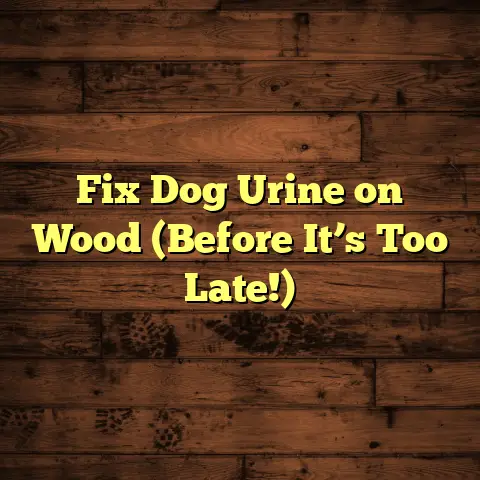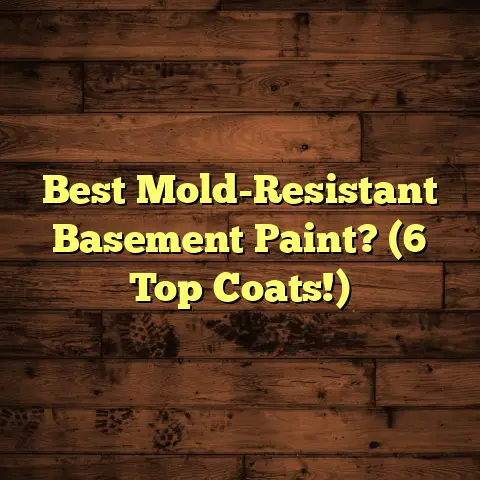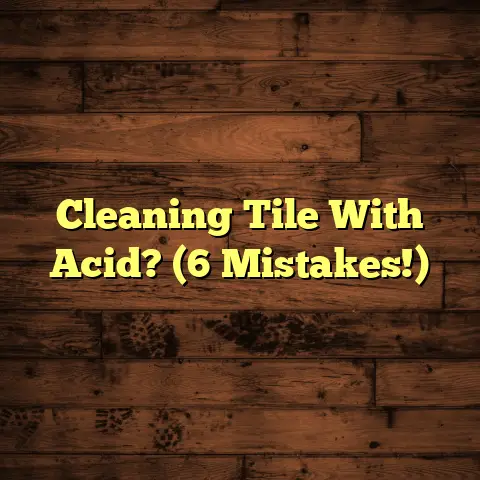Concrete Floor Paint: Use This Kind! (2 Options)
Remember that old garage, the one with the stained concrete floor that always seemed damp? Yeah, the one where my dad tinkered with his car, and the air always smelled like motor oil and possibility.
I can still picture it vividly: the low hum of the fluorescent lights, the scattered tools, and that cold, gray concrete. Then, one summer, everything changed. We painted that floor. I remember the thick, almost syrupy texture of the paint, the way it transformed that dull slab into something bright and…dare I say…inviting?
The scent of fresh paint filled the air, mingling with the familiar aroma of grease. It was like breathing new life into the whole space. It wasn’t just about aesthetics; it felt like we were protecting something, creating a more functional area.
That memory sticks with me, not just because it’s a fond one, but because it highlights the transformative power of concrete floor paint.
These days, painted concrete floors are everywhere – garages, basements, patios, even commercial spaces. Why? Because it’s a cost-effective way to boost durability, add visual appeal, and make cleaning a breeze.
But here’s the thing: not all concrete floor paint is created equal. Choosing the right type is crucial for a long-lasting, beautiful finish. So, let’s dive in and figure out which kind is right for you.
Understanding Concrete Floor Paint
So, what is concrete floor paint, exactly? Well, at its simplest, it’s a coating designed specifically for concrete surfaces. It’s formulated to withstand the unique challenges that concrete presents: things like moisture, alkalinity, and heavy wear.
Think of it as a shield, protecting your concrete from all sorts of nasty stuff.
Now, the composition can vary, but generally, concrete floor paint consists of a resin (the binder that holds everything together), pigments (for color, obviously!), and additives (to improve performance, like durability or UV resistance).
But here’s the real kicker: there are different types of resins, and that’s where the magic (or the misery) happens. Let’s look at the big players:
-
Latex: This is generally your most budget-friendly option. It’s water-based, easy to apply, and relatively low in VOCs (volatile organic compounds). However, it’s not the toughest kid on the block.
It’s best suited for low-traffic areas and interior spaces.
-
Epoxy: Now we’re talking serious protection. Epoxy paints are two-part systems that, when mixed, create a super hard, chemical-resistant finish. Think garages, workshops, and high-traffic commercial spaces.
They’re a bit more demanding to apply, but the results are worth it.
-
Polyurethane: Polyurethane coatings are known for their exceptional durability, abrasion resistance, and UV stability. They’re often used as a topcoat over epoxy to provide added protection and a high-gloss finish. They can be a bit pricey, but they’re tough to beat.
Why Use Concrete Floor Paint?
Okay, so we know what it is, but why bother painting your concrete floor in the first place?
Well, let’s start with the obvious: protection. Concrete is porous, meaning it soaks up spills like a sponge. Oil, grease, chemicals… they can all penetrate the surface and leave unsightly stains that are nearly impossible to remove.
Paint creates a barrier, preventing these substances from seeping in and causing permanent damage. It also protects against wear and tear from foot traffic, equipment, and even the elements.
Think about it: a painted garage floor is much easier to sweep or mop than bare concrete. Spills wipe up effortlessly, and you don’t have to worry about grinding dirt and debris into the surface.
But it’s not just about practicality. Paint can also dramatically enhance the visual appeal of a space. Let’s be honest, bare concrete is pretty boring. It’s cold, gray, and industrial-looking.
A fresh coat of paint can transform a drab basement into a bright, inviting living area, or turn a utilitarian garage into a showroom-worthy workspace.
And the best part? You can choose a color that reflects your personal style and complements the overall design of your home. Want a sleek, modern look? Go for a dark gray or black epoxy. Prefer something more cheerful? Opt for a bright, sunny yellow or a cool, calming blue acrylic.
The possibilities are endless!
Choosing the Right Type of Paint
Alright, let’s get down to brass tacks. Which type of concrete floor paint is right for your project?
I’m going to focus on two popular options: epoxy and acrylic. Both have their pros and cons, and the best choice will depend on your specific needs and budget.
Option 1: Epoxy Paint
Epoxy paints are the heavy hitters of the concrete floor coating world. As I mentioned earlier, they’re two-part systems consisting of a resin and a hardener. When mixed, these components react chemically to form a super-strong, durable finish.
Characteristics and Advantages:
-
Exceptional Durability: Epoxy coatings are incredibly resistant to abrasion, impact, and chemicals. They can withstand heavy foot traffic, vehicle traffic, and even spills of harsh solvents and acids.
-
Chemical Resistance: This is a big one, especially for garages and workshops. Epoxy is impervious to oil, gasoline, brake fluid, and many other common automotive chemicals.
-
High Gloss Finish: Epoxy creates a smooth, glossy surface that’s easy to clean and visually appealing.
-
Long Lifespan: With proper application and maintenance, an epoxy floor can last for many years.
Ideal Applications:
-
Garages: This is where epoxy really shines. Its durability and chemical resistance make it perfect for withstanding the abuse of vehicles, tools, and spills.
-
Workshops: If you’re a serious DIYer, epoxy will protect your floor from dropped tools, sawdust, and chemical spills.
-
Commercial Spaces: Epoxy is a popular choice for retail stores, warehouses, and other commercial environments where durability and aesthetics are important.
The Preparation Process:
Okay, here’s the deal: epoxy is not a forgiving coating. If you skimp on the prep work, you’re going to end up with a peeling, bubbling mess. Trust me, I’ve seen it happen.
Here’s the step-by-step process:
-
Surface Cleaning: This is absolutely critical. You need to remove all dirt, grease, oil, and other contaminants from the concrete surface. I recommend using a concrete degreaser and a stiff brush or power washer.
-
Etching: Concrete is naturally smooth, which makes it difficult for epoxy to adhere properly. Etching creates a slightly rough surface that the epoxy can grip onto.
You can etch concrete using muriatic acid or a commercial etching solution. Be sure to follow the manufacturer’s instructions carefully and wear appropriate safety gear (gloves, goggles, and a respirator).
-
Rinse Thoroughly: After etching, rinse the concrete thoroughly with clean water to remove any remaining acid or etching solution.
-
Drying: Allow the concrete to dry completely before applying the epoxy. This can take several days, depending on the humidity and temperature.
I always recommend using a moisture meter to check the moisture content of the concrete before proceeding. Ideally, it should be below 4%.
-
Priming (Optional): Some epoxy systems require a primer to improve adhesion and prevent outgassing (the release of air from the concrete, which can cause bubbles in the epoxy).
If your epoxy system recommends a primer, apply it according to the manufacturer’s instructions.
-
Mixing Components: Epoxy is a two-part system, so you’ll need to mix the resin and hardener together according to the manufacturer’s instructions. Use a drill with a mixing attachment to ensure that the components are thoroughly combined.
Be careful not to mix too much at once, as epoxy has a limited pot life (the amount of time you have to work with it before it starts to harden).
Tips for a Professional Finish:
-
Work in Sections: Apply the epoxy in small sections to prevent it from drying too quickly.
-
Use a Squeegee and Roller: A squeegee can help you spread the epoxy evenly, while a roller will smooth out any imperfections.
-
Spike Roller: I highly recommend using a spiked roller after applying the epoxy. This tool helps to release any trapped air bubbles and creates a smoother, more uniform finish.
-
Curing Times: Epoxy takes time to cure properly. Follow the manufacturer’s instructions for curing times, and avoid walking on or using the floor until it’s fully cured.
Typically, you’ll need to wait at least 24-48 hours before walking on the floor, and 5-7 days before parking a car on it.
Option 2: Acrylic Paint
Acrylic paint is another popular choice for concrete floors, especially for those looking for a more budget-friendly and user-friendly option.
Features and Benefits:
-
Ease of Use: Acrylic paint is water-based, making it easy to apply and clean up. It doesn’t require any special mixing or equipment.
-
Versatility: Acrylic paint can be used on a variety of concrete surfaces, including garages, basements, patios, and walkways.
-
Aesthetic Options: Acrylic paint comes in a wide range of colors and finishes, allowing you to create a custom look for your floor.
-
Lower Cost: Acrylic paint is generally less expensive than epoxy, making it a good option for those on a tight budget.
The Application Process:
The application process for acrylic paint is similar to that of epoxy, but it’s generally less demanding.
-
Surface Preparation: As with epoxy, surface preparation is crucial. Clean the concrete thoroughly to remove any dirt, grease, or oil.
-
Etching: Etching is still recommended for acrylic paint, as it helps to improve adhesion.
-
Priming: A primer is highly recommended for acrylic paint, especially on porous concrete surfaces. The primer helps to seal the concrete and create a more uniform surface for the paint.
-
Painting: Apply two coats of acrylic paint, allowing each coat to dry completely before applying the next. Use a roller or brush to apply the paint evenly.
-
Drying Times: Acrylic paint typically dries faster than epoxy. Follow the manufacturer’s instructions for drying times, and avoid walking on or using the floor until it’s fully dry.
Color and Design Choices
Okay, so you’ve chosen your paint type, now comes the fun part: picking a color!
Color can have a huge impact on the overall look and feel of a space.
Selecting Colors:
-
Consider the Size of the Space: Lighter colors can make a small space feel larger and more open, while darker colors can make a large space feel cozier and more intimate.
-
Think About the Lighting: Natural light can affect the way colors appear, so it’s important to consider the amount of natural light in the space when choosing a color.
-
Complement the Existing Decor: Choose a color that complements the existing decor in the space. If you have a lot of warm wood tones, for example, you might want to choose a cool-toned paint color.
Popular Color Trends:
-
Grays: Grays are a popular choice for concrete floors, as they’re versatile and can be used in a variety of design styles.
-
Beiges: Beiges are another popular neutral option that can create a warm and inviting space.
-
Blues: Blues can create a calming and relaxing atmosphere.
-
Greens: Greens can bring a touch of nature indoors.
Design Ideas:
-
Stenciling: Stenciling is a great way to add a unique touch to your concrete floor. You can use stencils to create patterns, borders, or even entire murals.
-
Patterns: You can create patterns using different colors of paint. For example, you could create a checkerboard pattern or a striped pattern.
-
Two-Tone Applications: A two-tone application can add visual interest to your concrete floor. For example, you could paint the main area of the floor one color and then paint a border or accent area a different color.
Maintenance and Care
Once you’ve painted your concrete floor, it’s important to maintain it properly to prolong its lifespan.
Cleaning Methods:
-
Sweep Regularly: Sweep your concrete floor regularly to remove dirt, dust, and debris.
-
Mop with a Mild Detergent: Mop your concrete floor with a mild detergent and water to remove spills and stains.
-
Avoid Harsh Chemicals: Avoid using harsh chemicals or abrasive cleaners on your concrete floor, as they can damage the paint.
Protective Coatings:
- Apply a Clear Sealer: Applying a clear sealer over your painted concrete floor can help to protect it from scratches, stains, and wear.
Touch-Up Tips:
- Touch Up Scratches and Chips: Touch up any scratches or chips in the paint as soon as possible to prevent them from spreading.
Common Problems and Solutions
Even with careful preparation and application, problems can sometimes arise with painted concrete floors.
Peeling:
-
Cause: Peeling is often caused by poor surface preparation, moisture problems, or the use of an incompatible paint.
-
Solution: Remove the peeling paint, prepare the surface properly, and apply a new coat of paint.
Bubbling:
-
Cause: Bubbling is often caused by outgassing from the concrete.
-
Solution: Use a primer to seal the concrete and prevent outgassing.
Fading:
-
Cause: Fading is often caused by exposure to sunlight.
-
Solution: Use a UV-resistant paint or apply a clear sealer with UV inhibitors.
Case Studies and Success Stories
I’ve seen so many successful concrete floor painting projects over the years. Here are a few examples:
-
The Garage Makeover: A homeowner transformed his drab, oil-stained garage into a showroom-worthy workspace with an epoxy floor in a sleek, dark gray. He added custom cabinets and tool storage, creating a space that was both functional and visually appealing.
-
The Basement Transformation: A family turned their unfinished basement into a bright and inviting living area with an acrylic-painted concrete floor in a warm, beige color. They added comfortable furniture, a large TV, and a game area, creating a space where the family could relax and spend time together.
These are just a few examples of the transformative effects of concrete floor paint. With the right paint and proper application, you can create a beautiful and durable floor that will last for years to come.
Conclusion
So, there you have it! A comprehensive guide to choosing and applying concrete floor paint.
We’ve covered everything from the different types of paint available to surface preparation, application techniques, and maintenance tips.
Remember, selecting the right concrete floor paint can significantly enhance both the functionality and aesthetics of any space. Whether you’re looking to protect your garage floor from spills and stains, transform your basement into a living area, or add a touch of style to your patio, concrete floor paint is a versatile and cost-effective solution.
Call to Action
Now it’s your turn! Take a look at your own concrete flooring options, whether it’s a garage, basement, or outdoor area, and envision the possibilities that the right paint can bring to your environment.
Don’t be afraid to get creative with colors, designs, and patterns. With a little planning and effort, you can transform your concrete floor into a stunning and durable surface that you’ll enjoy for years to come.
And if you ever need a hand, you know where to find me! Good luck with your project!





